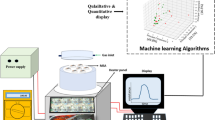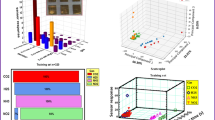Abstract
Mosquito-repellent is one of the most utilized products for dispelling mosquitoes that produce a significant quantity of gaseous, and particulate pollutants and are hazardous to human health. An indoor chamber experiment is conducted to identify the primary pollutants from mosquito repellents. This paper proposes an internet-of-things (IoT) based E-nose for volatile-organic compounds (VOCs)/gases/odors detection and real-time monitoring released from different mosquito repellents used in indoor environments. E-noses generate unique signature patterns for various VOCs/gases/odors. A gas sensor node interface is developed using eight cross-selective tin-oxide (MOX) based gas sensor arrays with a low-powered microcontroller to capture real-time signature patterns of VOCs/gases/odors released by different repellents when they are put in use. This microcontroller sends the gas sensor responses to the Amazon web services (AWS) cloud platform, from where data is ported to a remote data processing station (RDPS) for further analysis for its use in real-time. In this experiment, seven different types of mosquito repellents, viz mosquito coil, fast card, herbal cones, herbal spray, mosquito spray, hit spray and all-out liquid have been used. A dataset consisting of 1200 samples was captured. These sensor array responses are pre-processed using the two-stage analysis space transformation method, i.e., standardised linear discriminant analysis (SLDA) is used in the first stage. Subsequently, the second processing stage used Adaboost, random forest and recursive discriminant analysis (RDA) classifiers. The proposed e-nose was tested using 40 unknown VOCs/gases/odors samples that were not used during the training and validation. Experimentally, the RDA classifier trained in the SLDA transformed dataset could classify all 40 test samples with 100% accuracy. The lowest mean squared error achieved was 2.40 × 10–7.













Similar content being viewed by others
Availability of data and material
The associated data will be made available on reasonable request.
Abbreviations
- IAQ:
-
Indoor air quality
- IoT:
-
Internet-of-things
- MAE:
-
Mean absolute error
- MBE:
-
Mean bias error
- MOS:
-
Metal oxide semiconductor
- MSE:
-
Mean squared error
- MQTT:
-
Message queuing telemetry transport
- RDA:
-
Recursive discriminant analysis
- RF:
-
Random forest
- RMSE:
-
Root mean squared error
- RMSLE:
-
Root mean squared logarithmic error
- RRMSE:
-
Relative root mean squared error
- SLDA:
-
Standardised linear discriminant analysis
- VOC:
-
Volatile organic compounds
- WHO:
-
World Health Organisation
References
Liu WK, Wong MH, Mui YL. Toxic effects of mosquito coil (a mosquito repellent) smoke on rats: I. Properties of the mosquito coil and its smoke. Toxicol Lett. 1987;39(2–3):223–30.
Brown M, Adelaide AH. Insect repellents: an overview. J Am Acad Dermatol. 1997;36(2):243–9.
Lin TS. Indoor air pollution: unusual sources. 2019;636–642.
Wang L, Zheng X, Stevanovic S, Xiang Z, Liu J, Shi H, Yu M, Zhu C. Characterizing pollutant emissions from mosquito repellents incenses and implications in risk assessment of human health. Chemosphere. 2018;191:962–70.
Taneja A, Saini R, Masih A. Indoor air quality of houses located in the urban environment of Agra, India. Ann N Y Acad Sci. 2008;1140(1):228–45.
Sharma VP. Health hazards of mosquito repellents and safe alternatives. Curr Sci. 2001;80(3):341–3.
Liu WK, Sun SE. Ultrastructural changes of tracheal epithelium and alveolar macrophages of rats exposed to mosquito coil smoke. Toxicol Lett. 1988;41(2):145–57.
Gupta A, Nigam D, Gupta A, Shukla GS, Agarwal AK. Effect of pyrethroid-based liquid mosquito repellent inhalation on the blood–brain barrier function and oxidative damage in selected organs of developing rats. J Appl Toxicol. 1999;19(1):67–72.
Goel SG, Somwanshi S, Mankar S, Srimuruganandam B, Gupta R. Characteristics of indoor air pollutants and estimation of their exposure dose. Air Qual Atmos Health. 2021;14:1033–47.
Zhang J, Xue Y, Sun Q, Zhang T, Chen Y, Yu W, Xiong Y, Wei X, Yu G, Wan H, Wang P. A miniaturized electronic nose with artificial neural network for anti-interference detection of mixed indoor hazardous gases. Sens Actuators B Chem. 2021;326: 128822.
Taştan M, Gökozan H. Real-time monitoring of indoor air quality with internet of things-based E-nose. Appl Sci. 2019;9(16):3435.
Huang Y, Doh IJ, Bae E. Design and validation of a portable machine learning-based electronic nose. Sensors. 2021;21(11):3923.
Kinnera BKS, Subbareddy SR, Luhach AK. IOT-based air quality monitoring system using MQ135 and MQ7 with machine learning analysis. Scal Comput Pract Exp. 2019;20(4):599–606.
Akbar MA, Ali AAS, Amira A, Bensaali F, Benammar M, Hassan M, Bermak A. An empirical study for PCA-and LDA-based feature reduction for gas identification. IEEE Sens J. 2016;16(14):5734–46.
Li H, Luo D, Sun Y, Hosseini HG. Classification and identification of industrial gases based on electronic nose technology. Sensors. 2019;19(22):5033.
Rajput NS, Das RR, Mishra VN, Singh KP, Dwivedi R. A neural net implementation of SPCA pre-processor for gas/odor classification using the responses of thick film gas sensor array. Sens Actuators B Chem. 2010;148(2):550–8.
Mishra A, Rajput NS, Han G. NDSRT: an efficient virtual multi-sensor response transformation for classification of gases/odors. IEEE Sens J. 2017;17(11):3416–21.
Kumar K, Rajput NS, Shvetsov AV, Saif A, Sahal R, Alsamhi SH. ID2S4FH: a novel framework of intelligent decision support system for fire hazards. Fire. 2023;6(7):248. https://doi.org/10.3390/fire6070248.
Kumar K, Chaudhri SN, Rajput NS, Shvetsov AV, Sahal R, Alsamhi SH. An IoT-enabled e-nose for remote detection and monitoring of airborne pollution hazards using LoRa network protocol. Sensors. 2023;23(10):4885. https://doi.org/10.3390/s23104885.
Jasinski G, Wozniak L, Kalinowski P, Jasinski P (2018) Evaluation of the electronic nose used for monitoring environmental pollution. In: 2018 XV international scientific conference on optoelectronic and electronic sensors (COE). IEEE, pp 1–4
Acknowledgements
We acknowledge the support and guidance provided by IIT BHU, School of Electronics and Electrical Engineering, Lovely Professional University, India and Department of Computer Science, Nottingham Trent University, UK.
Funding
Funding is not received for this work.
Author information
Authors and Affiliations
Contributions
Major experimental work has been performed and written by Kanak Kumar, material introduction and performance analysis is written by Dr. Suman Lata Tripathi and discussion and concluding remark are written by Dr. Mufti Mahmud.
Corresponding author
Ethics declarations
Conflict of interest
There is no conflict of interest.
Ethics approval
NA. It does not produce any environmental hazards.
Additional information
Publisher's Note
Springer Nature remains neutral with regard to jurisdictional claims in published maps and institutional affiliations.
Rights and permissions
Springer Nature or its licensor (e.g. a society or other partner) holds exclusive rights to this article under a publishing agreement with the author(s) or other rightsholder(s); author self-archiving of the accepted manuscript version of this article is solely governed by the terms of such publishing agreement and applicable law.
About this article
Cite this article
Kumar, K., Tripathi, S.L. & Mahmud, M. Internet of Things Enabled Smart E-Nose System for Pollutants Hazard Detection and Real-Time Monitoring in Indoor Mosquito Repellents. SN COMPUT. SCI. 5, 438 (2024). https://doi.org/10.1007/s42979-024-02786-5
Received:
Accepted:
Published:
DOI: https://doi.org/10.1007/s42979-024-02786-5




